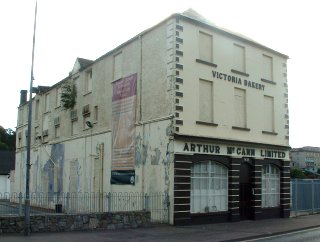The Environment and Heritage Service (EHS) is the Government body charged with the preservation of historic monuments and as part of a survey five and a half years ago produced an assessment of McCann’s Bakery.
Perhaps first we will look at the ‘Historical Information’ section of their Report and consider whether it is impartial, rigorous and accurate.
‘The earliest known map of Newry shows a three-storey castle where the bakery now stands. It was erected by Nicholas Bagenal who settled in Newry in 1539 to escape criminal prosecution in
Most probably he did this in, or shortly after 1566 when he repossessed the town, having been ousted some four years earlier by the Irish under Shane O’Neill. Given the various wars in subsequent decades and the fact that the town was often in the thick of the fighting, it is likely that the castle underwent major repairs from time to time.
According to the Frontier Sentinel of 3 April 1937, the staircase tower was demolished around 1755.’
The rest of the Historical Information refers to the later period. We will quote from it and comment upon it after this.
Concerning the above. Nicholas Bagenal, the fugitive from English justice, first took service with Con Bacach O’Neill as a mercenary. With the inside knowledge he had acquired, Bagenal changed sides, was pardoned in 1543 and later petitioned the English monarch for the confiscated lands of the ‘dissolved’ Cistercian Abbey, lands stretching to Carlingford, into South Armagh and into South Down as far as Greencastle; and for the powers and privileges of the office of Marshall of the English forces in Ireland.
These having been granted, he was shortly after overrun and driven from his newly granted possessions by the Irish under Shane O’Neill: later re-instated upon petition, he surely had little time or peace to erect from new a large defensive castle in Newry. His renewed petitions to
The plans – and the map in support, drawn by an unknown chartographer [sometimes identified as Robert Lythe] – are, we believe, no more than an attempt to ‘draw down grant aid’ – a tactic not unknown in the present day!! The endorsement on the map by Cecil (from 25 Feb 1571, Lord Burghley) – the English Queen’s closest advisor – is somewhat compromised by that Minister’s feted opposition to ecclesiastic jurisdiction and his record of persecution of ‘Papists’. The Abbot and vicars generals in the Abbott’s house – if that is what it was, and they were still in situ – would expect and receive little support or mercy from him.
In view of all this, why would Nicholas Bagenal NOT dispossess the latter from their fortified Abbott’s House, perhaps add further defences and then petition the Queen as if the whole construction costs fell upon him? The monasteries were plundered for their riches and often deliberately damaged to prevent their reuse, but as this was in the same decade, it is inevitable that most of the building(s) remained intact. Why would Marshall Bagenal not use them himself? And why would Burghley not support him in this (minor) deceit? The outcome would further the Queen’s writ in
This is offered as an alternative theory. There is more than circumstantial evidence for that building’s original function as Abbott’s House, which we will later add. However it is noted from our previous article that Henry, Nicholas’s son and heir, and heir too to the title of
One must therefore query why our present Council and its officials would choose to perpetuate into the third Christian millennium, the myth that this building’s greatest function in its lifetime was as the residence of Bagenal! It was much longer a modern bakery – indeed before that a low-grade residential area known as The Shambles – but especially before all, we believe, the final home of the ancient religious and secular leaders of Newry’s noble four-hundred-year-old Cistercian community.
Surely it is the latter that ought to be celebrated?
And how ironic is it that the first ever overwhelmingly-Nationalist leadership of Newry should endorse and perpetuate such a revisionist interpretation of our history?
Shame on those who opposed Councillor Casey’s motion to reverse the proposed name at a Council committee meeting some months ago!
